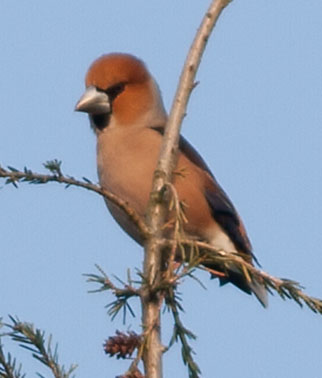Hawfinch (Coccothraustes coccothraustes)
broad-leaved woods, small copses and woodland edges
When: All year round
How many: Relatively small numbers

marked bird
Hawfinches have been noted in the New Forest for many years. John Wise, writing in the early 1860s, revealed an interest in these birds, as well as the Victorian predilection for shooting and collection. ‘A few pair now and then certainly remain in the Forest to breed’, said Wise, ‘though I have never been fortunate enough to obtain their eggs. Great quantities were killed at Burley in the spring of 1858’, he finished.
Today, no doubt as ever, the hawfinch remains one of the New Forest’s most secretive birds. Yet in winter, hawfinches fly in to the Blackwater Arboretum, a regularly used communal roost, and perch obligingly in full view of admiring throngs of bird-watchers before diving into dense cover provided by ornamental conifers.
Although not much longer than a greenfinch, the hawfinches heavy bill and thick, muscular neck makes them appear quite large, bulky creatures. Beautiful, subtly coloured plumage - a mixture of soft pinks, buffs, glossy blue-blacks, greys and dark and lighter browns - aids their desire for secrecy. A prominent black bib is distinctive, and so is typically finch-like, undulating flight during which hawfinches can be identified by strongly barred wings, short tail and heavy head.
Perhaps surprisingly, hawfinches are reasonably regular garden visitors, feeding on sunflower seeds, and taking newly sprouting buds and shoots from ornamental trees and shrubs.
That large, powerful bill appears somewhat incongruous, but is, in fact, specially adapted to help provide access to one of the hawfinch’s favourite foods: the central kernel of large, hard seeds that are accessed by using the bill to crack the surrounding, hard case.
Wild cherries and hornbeams, both of which are relatively scarce in the New Forest, are favourites, whilst beech nuts, holly and a variety of other fruits and seeds are quite happily taken. Indeed, it’s not unusual in autumn and winter to find hawfinches in the same vicinity as thrushes, feeding on haws and sloes, or seeking out invertebrates on the ground.
Spring, though, is often the best time to locate shy, elusive birds, the time when most cast off their wary mantle and exuberantly sing, staking a claim to territory, trying to attract a mate and then cementing the pair bond.
But not so with the hawfinch! Song, and the word seems to overstate it, is no more than a series of unremarkable, often muffled, barely audible clicks, ticks, peeps and squeaks that are just as likely to be heard in winter from perched or over-flying birds.
Bulky nests are constructed, often on horizontal branches well-up broadleaved trees. Single clutches of 3-6 eggs are usual, laid mainly between late-April and late-June.
Though not easy birds to census, hawfinches nationally are known to have declined considerably in recent years, but based largely on anecdotal evidence, the New Forest population seems to be holding up rather well.
References:
Collins Bird Guide: Killian Mullarney, Lars Svensson, Dan Zetterstrom and Peter J.Grant
The Shell Guide to the Birds of Britain and Ireland: James Ferguson-Lees, Ian Willis and J.T.R. Sharrock
Handbook of the Birds of Europe, the Middle East and North Africa, The Birds of the Western Palearctic (volumes 1-9): Stanley Cramp, et al
The New Forest: Its History and Scenery: John R. Wise
More links
Other related links
Search this site

Sadly, 58 animals were killed - 35 ponies, 13 cows, 8 donkeys and 2 sheep, whilst a further 32 were injured - 3 pigs, 9 donkeys, 11 cows and 9 ponies.
(Forty-three accidents occurred in daylight, 15 at twilight and 101 in the dark. Twenty-seven accidents were not reported by the driver involved).
Here's just one horrific example - Three donkeys killed in collision with van at notorious New Forest blackspot (Advertiser and Times)

